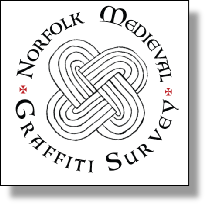









One of the universal motifs that occur all over the country, and throughout history, appear to be the creation of hand and shoe inscriptions. Echoing the very earliest of cave art, these inscriptions perhaps give more of a feeling of real people having been present than any others.
Many of the inscriptions are clearly drawn around actual hands and shoes, making them particularly individual and personal, and it has been suggested that some of the medieval examples show possible links with site of pilgrimage. However, shoes in particular are also inked to many other early beliefs, sometimes being concealed within buildings to ward off evil, and have known links with church ceremonies such as weddings.
In the post medieval period some of these inscriptions are undoubtedly memorial in nature, appearing with names, initials and dates inscribed within them. Some may be commemorating a visit to a site, whilst others, particularly those found on the lead of the church roof, appear to commemorate works undertaken on the building. At sites such as Morston in Norfolk, the base of the font is covered in a mass of foot and shoe inscriptions, some of which are relatively modern, whilst others are clearly medieval in date, making it clear that the practice has certainly been going on at this particular site for many, many centuries. Perhaps at sites such as this the presence of the earlier graffiti has simply legitimised the creation of the later inscriptions, leaving it open to multiple interpretations.











